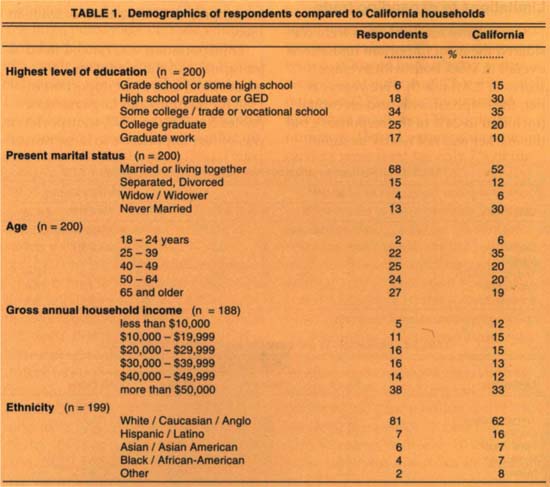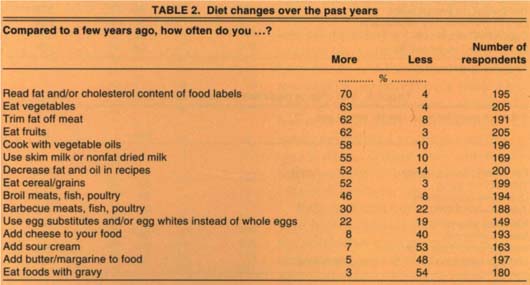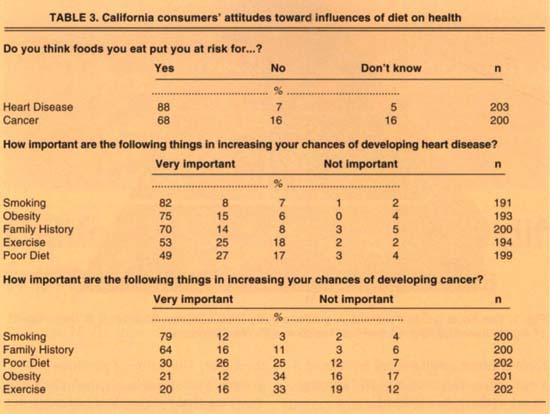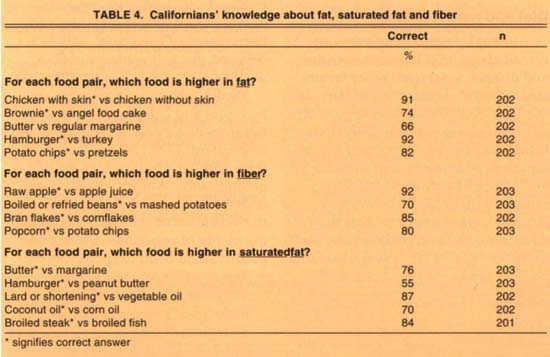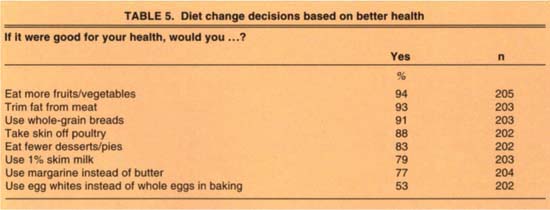All Issues
Californians' eating habits differ from their dietary attitudes
Publication Information
California Agriculture 50(5):22-26. https://doi.org/10.3733/ca.v050n05p22
Published September 01, 1996
Abstract
While California consumers are knowledgeable about general dietary recommendations, a recent survey found many are not aware of the recommended daily servings of fruit and vegetables, and do not always follow through on meal-time practices to lower dietary fat and increase fiber. Nutrition education should be targeted to correct misunderstandings about diet, and emphasize the values of eating fruit and vegetables and exercising to maintain good health.
Full text
As part of a multistate project, 200 Californians were asked about the roles of fat and fiber in the diet and their own consumption practices. Nearly all of the people surveyed said concerns about health and weight influenced what they ate.
National surveys indicate that more than 80% of Americans are concerned about the effects of diet on health. In the last 10 years, up to two-thirds of Americans said they had reduced their fat consumption, were eating less meat and more poultry, and eating more fruits and vegetables. However, marketplace consumption figures suggest that consumers may have overstated their compliance with dietary guidelines.
As part of a multistate project, a questionnaire was developed addressing consumer's knowledge and understanding of types of fats, sources of fats and fibers, consumption practices, and knowledge and adherence to the dietary guidelines for Americans established by the U.S. Department of Agriculture and U.S. Department of Health and Human Services. The questionnaire also identified constraints and motivating factors influencing dietary consumption changes.
The questionnaire, which was designed by scientists and evaluated by nutrition experts, was pilot-tested, and revised twice. Final questionnaires and postage-paid return envelopes were mailed in 1993 to a statistical sample of California households, with 300 questionnaires sent to women and 300 to men 18 years or older. Sample size was proportionate to the population in each zip code. Survey participation was voluntary and confidential. Of 600 surveys distributed, 205 usable questionnaires were returned with an adjusted return rate (discounting undeliverable questionnaires) of 42%.
Respondents primarily Caucasian
The gender and age ranges of the sample were evenly distributed. However, the majority of respondents were Caucasian, and formal education was higher than the state average (table 1). Three-quarters had at least some college education and most were currently employed. The sample included both urban and rural residents, and income was evenly distributed. In terms of health, 20% indicated they had been diagnosed with high blood pressure and 17% with high blood cholesterol. Less than 10% listed other conditions such as cancer or diabetes; some people may have had diseases without their knowledge. More than 80% did not follow a special diet for health reasons and the majority considered their health good or excellent.
Factors influencing diet
Nearly all (97%) of the respondents said concerns about health and weight influenced what they ate, with 58% indicating health and 45% noting that weight strongly influenced their dietary choices. Over half (54%) said food likes and dislikes played an important role in what they ate, 39% listed spouse influence, and 34% preparation time. Almost one-quarter said the cost of food influenced their food choice; however, almost three-fourths believed that eating healthier does not cost more.
The majority indicated they had made changes to improve their health and weight. These changes included reading the label for fat and cholesterol content, eating more fruits and vegetables, and reducing the amount of fat in their diet (table 2).
Fig. 1. The Food Guide Pyramid: A guide to daily food choices. Source: U.S. Department of Agriculture/U.S. Department of Health and Human Services
Diet and health beliefs
Although respondents were concerned about links between nutrition and disease, most rated other factors, such as family history and obesity, as more influential in developing cancer or heart disease (table 3). Only one-third ranked poor diet as very important in developing cancer; smoking and family history were correctly ranked highest. More than 90% strongly agreed or agreed that they were more likely to get heart disease if there was a lot of fat or saturated fat in their diet. The value of produce and grains seemed well accepted, with 85% agreeing that eating plenty of vegetables, fruits, and grain products would reduce their chance of getting heart disease. Conversely, only 57% believed that eating plenty of fiber would reduce the risk of heart disease.
Health authorities note there are both pro- and anticarcinogenic properties from dietary fat. About half of the respondents (52%) believed consuming a high-fat diet increases the risk of getting cancer. More than two-thirds correctly recognized they may reduce the likelihood of getting cancer by eating plenty of vegetables, fruits, grain products and fiber. Respondents also agreed that eating plenty of vegetables, fruits, and grains could reduce the frequency of intestinal problems. Consumers were more apt to recognize the relationship between dietary fat and heart disease than dietary fiber and cancer.
Knowledge about diet guidelines
While the respondents' ability to recognize USD A dietary recommendations was good, our survey found that the majority did not know specifics about the recommended number of daily servings. Only 34% knew they should eat five or more servings of fruits and vegetables daily, only 6% were aware that dietary guidelines recommend six to 11 servings of breads, cereals, pastas and rice daily, and 21% were aware of specific fat restrictions. Although many food labels display the food pyramid (fig. 1), consumers appear not to understand recommendation details. More emphasis is needed on the recommended number of servings in each category.
Consumers were knowledgeable about relative fat content of several common foods. Most were able to correctly distinguish which foods had more fat, saturated fat, or fiber (table 4). More than 90% knew that chicken with skin had more fat than chicken without, and hamburger had more fat than turkey. About three-quarters recognized brownies were higher in fat than angel food cake, and potato chips higher than pretzels. In contrast, less than one-quarter recognized there is no difference in fat level between butter and margarine.
Knowledge of sources of saturated fat was also good (table 4). More than 70% of respondents knew butter, lard / shortening and coconut oil were higher in saturated fat than margarine, vegetable oil and corn oil, respectively. More than four-fifths identified broiled steak as higher in saturated fat than broiled fish. Over half knew hamburger contains more saturated fat than peanut butter.
Consumers were unaware of sources of dietary cholesterol. Two-thirds knew cholesterol came from animal products such as meat and dairy; however, almost one-third incorrectly responded that all food containing fat or oil contains cholesterol.
Respondents' knowledge of relative fiber content was commendable (table 4). More than two-thirds (70%) knew boiled or refried beans are higher in fiber than mashed potatoes. The majority also identified popcorn and bran flakes as higher in fiber than potato chips and cornflakes, respectively. Ninety-two percent knew raw apple had more fiber than apple juice.
Changing dietary practices
Respondents indicated a willingness to adopt new strategies to reduce dietary fat and increase dietary fiber to improve health (table 5). Despite good intentions, however, not all reported following these strategies. For example, 93% had indicated they would be willing to trim fat from their meat, 66% said they follow this practice (tables 5 and 6). About 90% said they would remove the skin from poultry, but only 59% reported doing so always or often. Correspondingly, 78% said they would use skim milk, but only 67% reported using this low-fat product.
Only 34% of the respondents knew USDA dietary guidelines recommend eating five or more servings of fruits and vegetables daily.
Meat, fish, and poultry consumption
Many respondents reported using lower fat preparation methods (table 6). More than half said they “always or often” baked or broiled chicken and removed the chicken skin prior to consumption. Almost three-quarters said they usually or often eat fish or chicken instead of red meat and two-thirds trimmed all visible fat from red meat. The per-capita consumption reported in Agricultural Outlook confirms that U.S. consumption of red meat has dropped, with beef consumption dropping 12.9 pounds per person and poultry consumption increasing 16 pounds per person from 1985 to 1993.
Most people reported they had reduced, but not eliminated, meat/poultry consumption. Almost 40% said they had never eaten a vegetarian meal or used a meatless tomato sauce Only about 31% reported having a vegetarian dinner.
Milk and cheese consumption
Californians were reducing dairy fat consumption by selecting nonfat or low-fat milk, but were not switching to other lower-fat dairy products. Two-thirds said they often drank very low-fat (1%) or nonfat milk (table 6). Low-fat cheeses, however, were used less often. Similarly, respondents rarely substituted yogurt for sour cream when cooking. Only one-third said they often substitute lower-fat, frozen desserts for ice cream.
Fats and oils consumption
Less than half (42%) said they always or often add butter or margarine to vegetables, and only 20% always or often add sour cream, cheese or other sauces (table 6). Forty percent always or often ate bread products without butter. About two-thirds (68%) said they rarely eat a green salad without dressing; however, almost half always or often use a low-calorie dressing, low-calorie mayonnaise, or nonstick spray when cooking.
To improve their health and weight, the majority of people indicated they had changed their eating habits, including reducing the amount of fat in their diets. However, 54% said food likes and dislikes played an important role in what they ate.
Despite these statements, per-capita consumption reported in Agricultural Outlook showed no significant changes in total consumption of butter / margarine, shortening or salad/cooking oils.
Fruits, vegetables and salad consumption
Two-thirds of respondents said they were eating more fruits and vegetables than in the past (table 2), but less than half ate two vegetables at dinner (excluding a salad), and less than one-third ate vegetables at lunch (excluding lettuce). One-fourth said they rarely ate fruit with breakfast and one-third said they rarely ate raw vegetables as a snack. Raw fruits were more popular, eaten as snacks by about half of respondents.
While respondents reported consuming more fruits and vegetables, nationwide per-capita consumption data show an insignificant increase. Vegetable consumption has increased by less than one pound per year per person and fruit consumption also dropped from 1989 to 1991. This suggests Californians may be responding with the “right” answer rather than the answer reflecting actual behavior.
Whole-grain bread products were eaten by almost two-thirds of respondents (table 6). Similarly, almost two-thirds said they often ate cereal for breakfast, and ate potatoes with the skins. Most said they rarely served beans, peas, and lentils as a main course.
Exercise and health
Routine exercise, along with a healthy diet, can reduce the risk of heart disease. More than three-fourth of respondents believe lack of exercise contributes to the development of heart disease, with more than half finding it a very important factor.
Consumer attitudes
Consumer responses do not always reflect scientific fact. For example, about one-third of those surveyed consider exercise important in preventing cancer; however, this relationship has not been supported by scientific studies. Additionally, 16% believe dietary fat is related to bone problems; again, there is no scientific support for this statement.
Survey responses also may reflect the views, but not necessarily the behavior, of a more health-conscious population. For example, California respondents report consuming 1% or nonfat milk at a higher rate than sales indicate, suggesting we had a disproportionate number of diet-conscious people among our respondents or they incorrectly estimated their dietary practices.
Our findings demonstrate that a segment of Californians:
-
Recognize the important role of diet in health, especially as it relates to heart disease and certain cancers.
-
Read labels more frequently.
-
Trim fat from meats and skin from poultry.
-
Believe they decreased fat and oil consumption.
-
Believe they ate more fruits and vegetables.
Results clearly revealed areas for focused health education:
-
Consumers recognized the four food groups, but could not identify the daily recommended number of servings. Dietary guidelines should encourage increased consumption of breads/grains and fruits and vegetables.
-
People need to be encouraged to eat more produce, both at meals and as a healthy, between-meal snack.
-
Consumers were misinformed about fat and cholesterol. Nutritional education should dispel misconceptions about butter and margarine fat levels and encourage consumption of less total fat.
-
People should be reminded that lean meat can be part of a healthy diet.
-
Californians still underestimate the health benefits of regular exercise. Along with dietary education, the importance of regular exercise must be emphasized.




